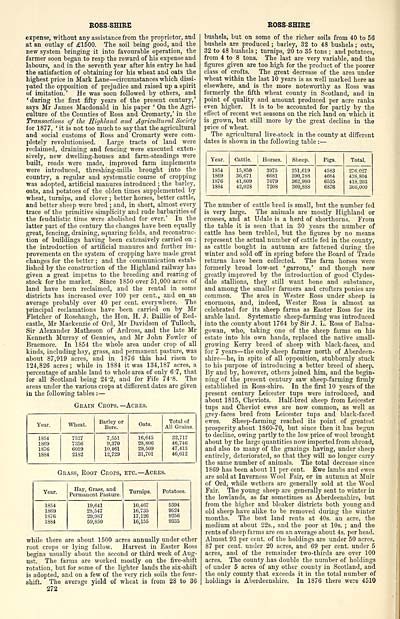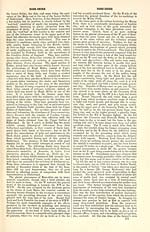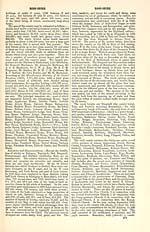Ordnance gazetteer of Scotland > Volume 6
(84) Page 272
Download files
Complete book:
Individual page:
Thumbnail gallery: Grid view | List view

BOSS-SHIRE
expense, without any assistance from the proprietor, and
at an outlay of £1500. The soil being good, and the
new system bringing it into favourable operation, the
farmer soon began to reap the reward of his expense and
labours, and in the seventh year after his entry he had
the satisfaction of obtaining for his wheat and oats the
highest price in Mark Lane — circumstances which dissi-
pated the opposition of prejudice and raised up a spirit
of imitation.' He was soon followed by others, and
' during the first fifty years of the present century, '
says Mr James Macdonald in his paper ' On the Agri-
culture of the Counties of Ross and Cromarty,' in the
Transactions of the Highland and Agricultural Society
for 1877, ' it is not too much to say that the agricultural
and social customs of Ross and Cromarty were com-
pletely revolutionised. Large tracts of land were
reclaimed, draining and fencing were executed exten-
sively, new dwelling-houses and farm-steadings were
built, roads were made, improved farm implements
were introduced, threshing-mills brought into the
country, a regular and systematic course of cropping
was adopted, artificial manures introduced ; the barley,
oats, and potatoes of the olden times supplemented by
wheat, turnips, and clover ; better horses, better cattle,
and better sheep were bred ; and, in short, almost every
trace of the primitive simplicity and rude barbarities of
the feudalistic time were abolished for ever.' In the
latter part of the century the changes have been equally
great, fencing, draining, squaring fields, and reconstruc-
tion of buildings having been extensively carried on ;
the introduction of artificial manures and further im-
provements on the system of cropping have made great
changes for the better ; and the communication estab-
lished by the construction of the Highland railway has
given a great impetus to the breeding and rearing of
stock for the market. Since 1850 over 51,000 acres of
land have been reclaimed, and the rental in some
districts has increased over 100 per cent., and on an
average probably over 40 per cent, everywhere. The
principal reclamations have been carried on by Mr
Fletcher of Rosehaugh, the Hon. H. J. Baillie of Red-
castle, Mr Mackenzie of Ord, Mr Davidson of Tulloch,
Sir Alexander Matheson of Ardross, and the late Mr
Kenneth Murray of Geanies, and Mr John Fowler of
Braemore. In 1854 the whole area under crop of all
kinds, including hay, grass, and permanent pasture, was
about 87,919 acres, and in 1876 this had risen to
124,826 acres; while in 1884 it was 134,187 acres, a
percentage of arable land to whole area of only 67, that
for all Scotland being 24-2, and for Fife 74-8. The
areas under the various crops at different dates are given
in the following tables : —
Grain
Crops. —Acres.
Year.
Wheat.
Barley or
Bere.
Oats.
Total of
All Grains.
1854
1869
1876
1884
7527
7356
6019
2182
7,551
9,370
10,461
12,729
16,645
28,806
29,509
31,701
32,717
46,746
47,413
46,612
Grass, Root Crops, etc. — Acres.
Year.
Hay, Grass, and
Permanent Pasture.
Turnips.
Potatoes.
1854
1869
1876
1884
19,641
28,547
29,987
59,850
10,467
16,735
17,126
16,155
5394
9524
9256
9335
while there are about 1500 acres annually under other
root crops or lying fallow. Harvest in Easter Ross
begins usually about the second or third week of Aug-
ust. The farms are worked mostly on the five-shift
rotation, but for some of the lighter lands the six-shift
is adopted, and on a few of the very rich soils the four-
shift. The average yield of wheat is from 28 to 36
272
ROSS-SHIRE
bushels, but on some of the richer soils from 40 to 56
bushels are produced ; barley, 32 to 48 bushels ; oats,
32 to 48 bushels ; turnips, 20 to 35 tons ; and potatoes,
from 4 to 8 tons. The last are very variable, and the
figures given are too high for the product of the poorer
class of crofts. The great decrease of the area under
wheat within the last 10 years is as well marked here as
elsewhere, and is the more noteworthy as Ross was
formerly the fifth wheat county in Scotland, and in
point of quality and amount produced per acre ranks
even higher. It is to be accounted for partly by the
effect of recent wet seasons on the rich land on which it
is grown, but still more by the great decline in the
price of wheat.
The agricultural live-stock in the county at different
dates is shown in the following table : —
1876
18S4
Cattle. Horses.
15,850
36,671
41,609
42,028
3975
6681
7079
7208
Sheep.
251,619
390,788
362,980
309,8SS
Pigs.
4583
6535
6876
Total.
276,027
43S.804
418,203
366,000
The number of cattle bred is small, but the number fed
is very large. The animals are mostly Highland or
crosses, and at Udale is a herd of shorthorns. From
the table it is seen that in 30 years the number of
cattle has been trebled, but the figures by no means
represent the actual number of cattle fed in the county,
as cattle bought in autumn are fattened during the
winter and sold off in spring before the Board of Trade
returns have been collected. The farm horses were
formerly broad low-set 'garrons,' and though now
greatly improved by the introduction of good Clydes-
dale stallions, they still want bone and substance,
and among the smaller farmers and crofters ponies are
common. The area in Wester Ross under sheep is
enormous, and, indeed, Wester Ross is almost as
celebrated for its sheep farms as Easter Ross for its
arable land. Systematic sheep-farming was introduced
into the county about 1764 by Sir J. L. Ross of Balna-
gowan, who, taking one of the sheep farms on his
estate into his own hands, replaced the native small-
growing Kerry breed of sheep with black-faces, and
for 7 years — the only sheep farmer north of Aberdeen-
shire — he, in spite of all opposition, stubbornly stuck
to his purpose of introducing a better breed of sheep.
By and by, however, others joined him, and the begin-
ning of the present century saw sheep-farming firmly
established in Ross-shire. In the first 10 years of the
present century Leicester tups were introduced, and
about 1815, Cheviots. Half-bred sheep from Leicester
tups and Cheviot ewes are now common, as well as
grey-faces bred from Leicester tups and black-faced
ewes. Sheep-farming reached its point of greatest
prosperity about 1860-70, but since then it has begun
to decline, owing partly to the low price of wool brought
about by the large quantities now imported from abroad,
and also to many of the grazings having, under sheep
entirely, deteriorated, so that they will no longer carry
the same number of animals. The total decrease since
1869 has been about 11 per cent. Ewe lambs and ewes
are sold at Inverness Wool Fair, or in autumn at Muir
of Ord, while wethers are generally sold at the Wool
Fair. The young sheep are generally sent to winter in
the lowlands, as far sometimes as Aberdeenshire, but
from the higher and bleaker districts both young and
old sheep have alike to be removed during the winter
months. The best land rents at 40s. an acre, the
medium at about 22s., and the poor at 10s. ; and the
rents of sheep farms are on an average about 4s. per head.
Almost 93 per cent, of the holdings are under 50 acres,
87 per cent, under 20 acres, and 69 per cent, under 5
acres, and of the remainder two-thirds are over 100
acres. The county has double the number of holdings
of under 5 acres of any other county in Scotland, and
the only county that exceeds it in the total number of
holdings is Aberdeenshire. In 1876 there were 4510
expense, without any assistance from the proprietor, and
at an outlay of £1500. The soil being good, and the
new system bringing it into favourable operation, the
farmer soon began to reap the reward of his expense and
labours, and in the seventh year after his entry he had
the satisfaction of obtaining for his wheat and oats the
highest price in Mark Lane — circumstances which dissi-
pated the opposition of prejudice and raised up a spirit
of imitation.' He was soon followed by others, and
' during the first fifty years of the present century, '
says Mr James Macdonald in his paper ' On the Agri-
culture of the Counties of Ross and Cromarty,' in the
Transactions of the Highland and Agricultural Society
for 1877, ' it is not too much to say that the agricultural
and social customs of Ross and Cromarty were com-
pletely revolutionised. Large tracts of land were
reclaimed, draining and fencing were executed exten-
sively, new dwelling-houses and farm-steadings were
built, roads were made, improved farm implements
were introduced, threshing-mills brought into the
country, a regular and systematic course of cropping
was adopted, artificial manures introduced ; the barley,
oats, and potatoes of the olden times supplemented by
wheat, turnips, and clover ; better horses, better cattle,
and better sheep were bred ; and, in short, almost every
trace of the primitive simplicity and rude barbarities of
the feudalistic time were abolished for ever.' In the
latter part of the century the changes have been equally
great, fencing, draining, squaring fields, and reconstruc-
tion of buildings having been extensively carried on ;
the introduction of artificial manures and further im-
provements on the system of cropping have made great
changes for the better ; and the communication estab-
lished by the construction of the Highland railway has
given a great impetus to the breeding and rearing of
stock for the market. Since 1850 over 51,000 acres of
land have been reclaimed, and the rental in some
districts has increased over 100 per cent., and on an
average probably over 40 per cent, everywhere. The
principal reclamations have been carried on by Mr
Fletcher of Rosehaugh, the Hon. H. J. Baillie of Red-
castle, Mr Mackenzie of Ord, Mr Davidson of Tulloch,
Sir Alexander Matheson of Ardross, and the late Mr
Kenneth Murray of Geanies, and Mr John Fowler of
Braemore. In 1854 the whole area under crop of all
kinds, including hay, grass, and permanent pasture, was
about 87,919 acres, and in 1876 this had risen to
124,826 acres; while in 1884 it was 134,187 acres, a
percentage of arable land to whole area of only 67, that
for all Scotland being 24-2, and for Fife 74-8. The
areas under the various crops at different dates are given
in the following tables : —
Grain
Crops. —Acres.
Year.
Wheat.
Barley or
Bere.
Oats.
Total of
All Grains.
1854
1869
1876
1884
7527
7356
6019
2182
7,551
9,370
10,461
12,729
16,645
28,806
29,509
31,701
32,717
46,746
47,413
46,612
Grass, Root Crops, etc. — Acres.
Year.
Hay, Grass, and
Permanent Pasture.
Turnips.
Potatoes.
1854
1869
1876
1884
19,641
28,547
29,987
59,850
10,467
16,735
17,126
16,155
5394
9524
9256
9335
while there are about 1500 acres annually under other
root crops or lying fallow. Harvest in Easter Ross
begins usually about the second or third week of Aug-
ust. The farms are worked mostly on the five-shift
rotation, but for some of the lighter lands the six-shift
is adopted, and on a few of the very rich soils the four-
shift. The average yield of wheat is from 28 to 36
272
ROSS-SHIRE
bushels, but on some of the richer soils from 40 to 56
bushels are produced ; barley, 32 to 48 bushels ; oats,
32 to 48 bushels ; turnips, 20 to 35 tons ; and potatoes,
from 4 to 8 tons. The last are very variable, and the
figures given are too high for the product of the poorer
class of crofts. The great decrease of the area under
wheat within the last 10 years is as well marked here as
elsewhere, and is the more noteworthy as Ross was
formerly the fifth wheat county in Scotland, and in
point of quality and amount produced per acre ranks
even higher. It is to be accounted for partly by the
effect of recent wet seasons on the rich land on which it
is grown, but still more by the great decline in the
price of wheat.
The agricultural live-stock in the county at different
dates is shown in the following table : —
1876
18S4
Cattle. Horses.
15,850
36,671
41,609
42,028
3975
6681
7079
7208
Sheep.
251,619
390,788
362,980
309,8SS
Pigs.
4583
6535
6876
Total.
276,027
43S.804
418,203
366,000
The number of cattle bred is small, but the number fed
is very large. The animals are mostly Highland or
crosses, and at Udale is a herd of shorthorns. From
the table it is seen that in 30 years the number of
cattle has been trebled, but the figures by no means
represent the actual number of cattle fed in the county,
as cattle bought in autumn are fattened during the
winter and sold off in spring before the Board of Trade
returns have been collected. The farm horses were
formerly broad low-set 'garrons,' and though now
greatly improved by the introduction of good Clydes-
dale stallions, they still want bone and substance,
and among the smaller farmers and crofters ponies are
common. The area in Wester Ross under sheep is
enormous, and, indeed, Wester Ross is almost as
celebrated for its sheep farms as Easter Ross for its
arable land. Systematic sheep-farming was introduced
into the county about 1764 by Sir J. L. Ross of Balna-
gowan, who, taking one of the sheep farms on his
estate into his own hands, replaced the native small-
growing Kerry breed of sheep with black-faces, and
for 7 years — the only sheep farmer north of Aberdeen-
shire — he, in spite of all opposition, stubbornly stuck
to his purpose of introducing a better breed of sheep.
By and by, however, others joined him, and the begin-
ning of the present century saw sheep-farming firmly
established in Ross-shire. In the first 10 years of the
present century Leicester tups were introduced, and
about 1815, Cheviots. Half-bred sheep from Leicester
tups and Cheviot ewes are now common, as well as
grey-faces bred from Leicester tups and black-faced
ewes. Sheep-farming reached its point of greatest
prosperity about 1860-70, but since then it has begun
to decline, owing partly to the low price of wool brought
about by the large quantities now imported from abroad,
and also to many of the grazings having, under sheep
entirely, deteriorated, so that they will no longer carry
the same number of animals. The total decrease since
1869 has been about 11 per cent. Ewe lambs and ewes
are sold at Inverness Wool Fair, or in autumn at Muir
of Ord, while wethers are generally sold at the Wool
Fair. The young sheep are generally sent to winter in
the lowlands, as far sometimes as Aberdeenshire, but
from the higher and bleaker districts both young and
old sheep have alike to be removed during the winter
months. The best land rents at 40s. an acre, the
medium at about 22s., and the poor at 10s. ; and the
rents of sheep farms are on an average about 4s. per head.
Almost 93 per cent, of the holdings are under 50 acres,
87 per cent, under 20 acres, and 69 per cent, under 5
acres, and of the remainder two-thirds are over 100
acres. The county has double the number of holdings
of under 5 acres of any other county in Scotland, and
the only county that exceeds it in the total number of
holdings is Aberdeenshire. In 1876 there were 4510
Set display mode to: Large image | Transcription
Images and transcriptions on this page, including medium image downloads, may be used under the Creative Commons Attribution 4.0 International Licence unless otherwise stated. ![]()
| Gazetteers of Scotland, 1803-1901 > Ordnance gazetteer of Scotland > Volume 6 > (84) Page 272 |
|---|
| Permanent URL | https://digital.nls.uk/97388610 |
|---|
| Attribution and copyright: |
|
|---|---|

